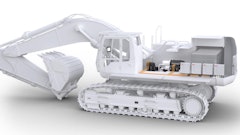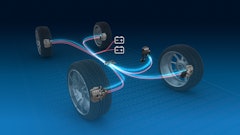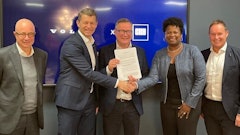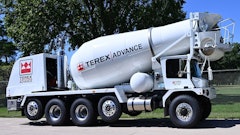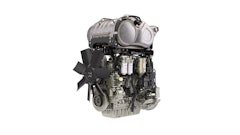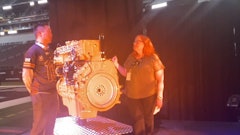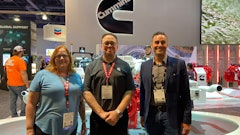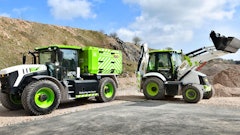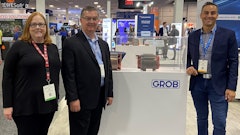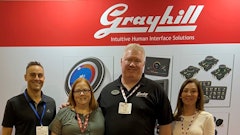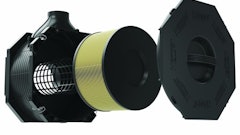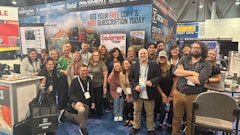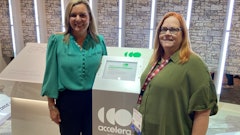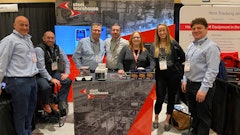Every day, milk trucks leave Hilarides Dairy and head northwest to Hilmar Cheese Co. Inside the tanker trailer and the composite cylinders installed in the Peterbilt's sleeper are valuable commodities provided by the dairy's Jersey cows. There's the fresh milk, as well as manure dropped by the 9,000 cows living at the dairy, which fuels the truck (after a few steps). The Lindsay, CA-based fleet is said to be the first in the country to use biomethane produced entirely on the farm.
The introduction to the cow-powered truck took place this year at World Ag Expo, Tulare, CA, and concluded with a toast of milk to Rob Hilarides and the red and white Peterbilt parked in his booth. In 2007, California provided 22% of the nation's total production of milk, according to the California Milk Advisory Board. Hilarides Dairy is one of 1,960 such operations that help make California the No. 1 dairy state. The state's milk cow population is estimated to be 1.83 million.
Waste not
Keeping all of those happy cows healthy means there's no shortage of manure. Five years ago, Hilarides began drawing methane from the dairy's lagoons to fuel a bank of engines. Today, those engines produce all of the electricity used on his farm.
"Because we had more biogas than we needed to produce electricity, and since we haul our own product, we decided to purify some of the gas and run it in our vehicles to offset our diesel fuel expenses," says Hilarides.
The Lindsay biomethane project is the result of a public-private partnership that is a "model for success not just in California but around the country," says Michael Marsh, CEO, Western United Resource Development Inc., Modesto, CA, which through its Dairy Power Production Program, encourages the development of biogas-based electricity generation.
"In California, the manure is plentiful, the technology is here, and public-private partnerships can make this work," says Allen Dusault, director of sustainable agriculture, Sustainable Conservation, San Francisco, CA. "Biomethane is the only vehicle fuel that is carbon negative. The production process prevents greenhouse gases from reaching the atmosphere, and the resulting fuel is clean-burning."
Want not
Manure is flushed from the cows' freestalls into a lagoon where gravity separates solids from liquids; the latter is then piped to a covered lagoon where bacteria goes to work. The biogas that is released naturally is about 70% methane, says Hilarides. "Once you get the other things out of the biogas, such as carbon dioxide and hydrogen sulfide, you get a product that is basically the same as natural gas from the pipeline."
As biogas collects under the lagoon cover, fans draw it through pipes to the processing building nearly 2,000 ft. away. The generators run fine on the lagoon gas, but for the compressed natural gas (CNG) engines in the milk trucks, a portion is routed to a Biogas Upgrading System (BUS) developed by Phase 3 Renewables, Cincinnati, OH.
"The system can clean the biogas up to 99.5%," says Norma McDonald, operating manager, Phase 3. "For truck engines, fuel density matters because Rob wanted his over-the-road miles to be as long as possible, and you don't want to waste energy by compressing carbon dioxide that has no fuel value. We want it to be as rich of a gas a possible. But there is a curve; as in most separation systems, removing that last 2% can cost as much as the first 90%." Ultra-pure gas is usually not worth the extra cost of producing it.
After flowing through the BUS, the clean biomethane is stored at around 3,600 psi in large stationary cylinders.When OEM Off-Highway toured the dairy, they contained 98% pure methane.
Phase 3's business model is to create systems that will work on a relatively small scale, such Hilarides' application. While Hilarides is the first Phase 3 customer to produce fuel for his own fleet, other dairy operations have set up systems that sell natural gas directly into the pipeline.
"Hilarides' system is probably 1/10th the size that other companies told me could work," says McDonald. For the Hilarides Dairy system, Phase 3 took what it had learned on its earlier installations and scaled it down. Early on "we looked at what it would take to sell 100 systems," says McDonald. "We figured it takes a lot of time and money to build the processing system on site."
The result of Phase 3's work to produce a smaller system is the skid-mounted BUS separator installed at Hilarides Dairy. It was assembled in Michigan and hauled in three sections to California.
Ready for 2010
While the BUS system installed in Lindsay is new, the Cummins Westport (CWI) ISL G 320 engine that Kustom Products, Coos Bay, OR, retrofitted into Hilarides' Peterbilt can be found in new buses and trucks around the country.
A joint venture between Cummins and alternative fuel specialist Westport Innovations Inc., Vancouver, BC, Canada, CWI recently announced that North American Bus Industries Inc. (NABI) placed an order for 260 ISL G engines for its CompoBus, a 45-ft. bus made from a lightweight composite material. Late last year, California's Port of Long Beach took delivery of 132 Sterling tractors that have been repowered with CWI ISL G engines burning LNG fuel.
CWI's flagship engine, the ISL G meets 2010 emission standards of 0.2 g/bhp-hr (grams per brake hp hour) NOx and 0.01 g/bhp-hr PM. Based on the Cummins ISL, the engine uses Cummins' cooled exhaust gas recirculation (EGR).
Electronics compensate for variations in fuel quality and operating conditions allowing the spark-ignited ISL G to be run on fuel such as compressed or liquid natural gas and biomethane — which is commonly collected from landfills.
Even with milk trucks covering a round trip of nearly 300 miles everyday, Hilarides Dairy won't have to worry about biomethane shortages anytime soon.
With 9,000 head of cattle working around the clock, there's plenty of methane to go around. The purification system runs only eight hours a day. Hilarides Dairy currently has two milk trucks running ISL G engines, and plans to convert more when milk prices improve.
"Rob Hilarides has 12 big rigs on the road every day, so he controls his own market for biomethane," says McDonald. "If there is a prevailing suggestion I give to farmers looking to justify such a system, it is for them to use as much of the fuel as they can on the farm. They should install it for themselves first, and then sell it if it makes sense. First and foremost, they should use the energy to replace retail purchases."





